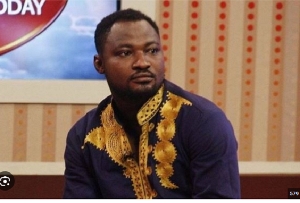Opinions of Tuesday, 31 August 2004
Columnist: Chronicle
Who rules Anlo in the interim: Awodada or Regent?
The calls for research on who is who in the Anlo Kingdom has become imperative, most especially when Awadada Togbi Agbesi Awusu II lambasted the eleven (11) divisional chiefs led by Regent Togbi Sri who paid a courtesy call on the Volta Regional Minister ? Mr. Owusu Yeboah to extend their appreciation, through the Minister to the President, H.E. J.A. Kufuor for the series of development jobs earmarked for the Anlo State, amidst other problems.
Awadada?s unhealthy behaviour has really created a very bad impression about Anlo chiefs in the nation and world-wide. This dastardly and unscholarly behaviour the Awadada put up did not only lower the status and standard of Anlo chiefs but portrayed and created the public perception that members of the Anlo Traditional Council, ATC, were leaders without focus and bearing.
The youth, forced by these unfortunate circumstances, conducted a diligent search on who the light of the Anlo cultural heritage was and to their utter dismay, identified that Awadada, was not after all a chief. This is because he presently occupies a position reserved for members of the two clans who are the heirs to the kingship: the Royal Bate and the Royal Adzorvia. Rightly, it is only these two clans who can litigate their terms of occupation of the Awormezi and therefore can claim the title of ruler of the Anlo Kingdom.
In the absence of this king/ruler, the chieftaincy Act 370 comes into play. This Act states that in the absence of the Awomefia, the next senior in rank acts as the head of the Anlo Traditional Council of chiefs.
Our research reveals that the Awadada (who is not a chief, but professes to be), is not installed in any special ceremony with an authority of a stool. In this regard, he cannot be an embodiment of the ancestors in whose name he shall command the actions of the living. As a result, his proclamations are not sacred and binding on the people.
Again, the youth discovered that the Awadada?s position was created on military basis during the pre-colonial days for him to lead Anlo soldiers to the battlefield. Clarified further, the Awoamefia, by virtue of his position, does not go to war. Instead, the paramount chiefs go to the battlefield. Additionally, by virtue of his post as an army officer, Awadada is a fetish priest and is dressed in white. That is why the Awadada?s dressing differs from any other chief, including the Awoamefia.
Simply put, the Awadada is a priest of war. Though he represents the Awoamefia on the battlefield, he does not take part in the battle. His duty is to supply reserved soldiers to any wing getting diminished and see to the treatment of wounded soldiers. All food sent to the battlefield are kept in his custody and the spot he occupies is called Atsefuma and is protected with charms to avoid invasion by the enemies.
On the other hand, Awadada comes from the Agave clan and installed by this clan without any installation rituals done for him as undergone by the chiefs within the Anlo state. Of note is the fact that, Awadada is a priest for a specific function. This disqualifies him from assuming the status of chief, let alone the Awoamefia. Also of note is the fact that Awadada is on the same status and function (category) as Togbi Naza I, the Nyigblanua of Alakple. As he has Togbi Nyigbla; it is the same way that the Awadada heads the Anlo war-god called Kaklaku. In spite of this similarity, there is a big disparity between them ? our research indicated. Nyigblanua Naza is senior in rank to Awadada. This is because Togbi Nyigbla is one of the gods brought from Hogbe and with an established system of worship prior to the need for the creation of the shrine for Awadada and the state war-god Kaklaku. The question the youth asked is, do the Nyigblanua or Horgbatonua classify themselves as chiefs?
Not only this, but other findings reveal that Awadada does not fall within the category of chiefs as created by the Chieftaincy Act 370. Since the Awadada does not control any town, as surprisingly identified from a research, he controls nowhere and that is why he has no representation at the Regional House of Chiefs.
Once Awadada is not a chief, the role of divisional chief he proclaims to perform is a hallucination and the title of President of Anlo Traditional Council he conferred on himself is a display of neurosis. Put differently, Awadada is not a chief because the Chieftaincy Act and the procedure laid down for installing chiefs in Anlo do not cover his position, did not make provision for him.
In Anlo, the Lafe and Amlade clans install all chiefs, including the Awoamefia. This means that those two leading clans perform the installation rituals and once these two clans, as tradition demands in Anlo, do not install the Awadada, he is not qualified as a chief.
Added to the above, the Questionnaire Form that allows installation of chiefs in the Anlo state provides no column for Awadada; knowing very well that he does not perform any function as a chief and his duty does not resemble that of chiefs.
Research further unfolds that in the Anloland, a person can only be called a chief after successfully undergoing all the ritualistic installation processes, including the ritualistic ?sandalling.? Awadada is not sandaled by the Awoamefia, therefore, the chief status he claims is only a nickname. Also, he cannot assume the status of the President of the Anlo House of Chiefs in the presence of qualified chiefs installed on the tenets and norms of Anlo culture. Is it not ridiculous that the Awadada who is yet to be introduced to the Awomefia, who would in turn introduce him to the Anlo Traditional Council of chiefs to take action to gazette him, says he is the President of the chiefs who are yet to process his procedure of being gazetted as a chief?
On the other side of the coin, our research indicated that so much has changed nowadays in the life styles of chiefs and their fetish priests (Awadada). Chiefs no longer go to war and they need no juju for protection to defend the people in war (Awadada?s function). Here, research reveals that this need in pre-colonial era, culminated in the creation of Awadada (Asafohene) and the war-god called Kaklaku.
Now, chiefs need education to plan, organize, direct and control their people to achieve the desired results. Also, myths, which were used to hold the people spellbound in fear, are being questioned by education.
Natural events, which were seen as mysteries and referred to as oracles for explanation, are being explained and resolved by science and technology. Ethnic groups that were enemies have now come together as a nation with a constitution greater than the dos and don?ts of ethnicity. In the same way, powerful and dictatorial chiefs have learnt to respect the rule of law.
Yes, due to the above changes in the Anlo Kingdom, no wars or food to be supplied to soldiers on the battlefield; the Awadada?s role no longer exists. Awadada has become functionless and powerless. The late Togbi Adeladza II of Anlo state said this several times but unfortunately, did not muster courage enough to confine Awadada to his Kaklaku shrine.
Instead, Togbi Adeladzea made a sad mistake in a proclamation headed ?Restructuring of Anlo Wings From Military Bases to Civilian Division? written on the 4th February 1991, and dispatched to all chiefs on the 15th February 1991. Though he made all chiefs aware that Awadada had become a liability and a placeholder due to modern effects on chieftaincy, he suggested the change of role for Awadada but could not get the support of the permanent members of the Anlo House of Chiefs to effect his ideas, into action. The Tsiame Traditional Council in an open letter dated 24th July, 1991 to Togbi Adeladza II, signed by Mr. P.K.K. Avetsi were unhappy with the Awoamefia for attempting to pass a draconian decision without the consent and concurrence of the chiefs in the Anlo Kingdom. The late Togbi Adeladza regretted the unfair way he developed the issue.
The youth want Awadada to know that every record within their reach indicates that he is not a chief by any standing but a traditional military officer and now that there are no wars, he is a liability to the state and should stop projecting himself as a chief. Also, relevant documents have sufficient basis for the youth to take Awadada to court should he be seen anywhere projecting himself as a chief and acting President to the Anlo Traditional Council. The Royal Adzorvia clan who are the legitimate heirs to the Awoamezi throne now creates his position.
Here comes the question of a non-chief leading chiefs to the Regional Minister. Our research and relevant documents at hand prove that Fiadomegatala (Regent Togbi Sri) has reference in theAnlo Kingdom and his status is created by the Royal Adzorvia clan, the legitimate heirs to Awoamezi.
Throughout the time - consuming and Herculean task taken by the youth to get access to the facts and documents written in gold and kept in Royal Adzorvia archives, the youth were presented with records on Regent Togbi Sri III.
The youth have also identified that there are certain individuals, both home and abroad who know about the sad state the Anlo kingdom is thrown into and would have helped correct it but failed, due to fear. These people fear to speak the plain truth and correct misconceptions and inaccuracies on the Anlo land but failed on the grounds that, they may lose their peers.
Those who hate the Regent, Togbi Sri III and want to pull his leg are also on record. Taking Biblical allusions to equate Regent Sri III?s role, we only link him with what John the Baptist did for our Lord Jesus Christ. Literarily, John the Baptist cleared the way for the Lord Jesus and created awareness on the coming of Jesus, so is the Regent Sri taking his valuable time to show how powerful Togbi Sri III would be like. I quote Regent Togbi Sri III?s Christmas and New Year message to Fiagawo, Fiawo, opinion leaders as well as all Anlos on the 24th December 2003.
?I appeal to all chiefs and people of Anlo to unite your ranks and resist any attempt to destablise the smooth installation of the Awomefia. The Royal House assures the people of Anlo that it will surely come out with the installation of an Awomefia in the coming year.?
From the above, our Fiadomegatala to the Awomezi stool did not indicate anywhere that he is the all in all in Anlo. The scenario he created is a means to an end. Evidently, on the Fiadomegatala?s appointment by the Royal Adzoavia House, he was introduced to the Anlo Traditional Council who accepted and approved him.
Conclusively, Fiadomegatala is by virtue of his nomination, and acceptance by Anlo House of Chiefs, the light of Anlo heritage, the Royal monarch assuming this title by virtue of the Royal ranking to tap inalienable and absolute power for the throne and resolve the Anlo chieftaincy conflicts before our long awaited Togbi Sri III is installed and out-doored.












